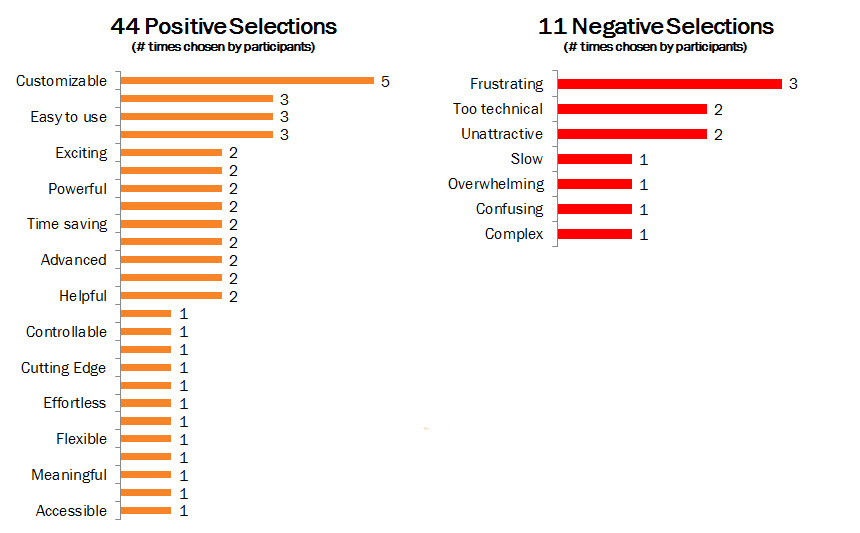Hello
This month's newsletter will focus on how to use the Product Reaction Cards, which is a simple and quick survey that you can give participants at the end of a usability study to learn how they feel about your product.
Thanks to June, a faithful 'Tidbit reader, for asking me to write about this topic. Please continue to send me your questions and suggestions for other topics you'd like me to cover in future editions of Tidbits.
Happy Spring (even though it's supposed to snow 10 inches tonight)!
Kay
***********************
Product Reactions Cards measure desirability
The Product Reaction Card survey is a set of 118 positive and negative attributes such as “Accessible”, “Creative”, “Frustrating”, “Gets in the Way”, and “Helpful”. For logistical reasons, rather than handing them a stack of cards, most of the time I give the person a single sheet of paper with all the attributes printed on it.
At the end of an in-person or remote usability session I show the page to the participant and ask them to spend one minute reviewing the list, and then quickly pick five attributes that match how they feel about the product they just reviewed.
Most find this exercise light hearted and fun at the end of a hour of heavy-duty thinking. Once they're done, we go over their word choices, using them as a device for discussing their feelings around their feelings about the product. The cards are a great tool to help the transition from capturing logical usability feedback to their emotional reactions.
Things get interesting when the participant's choices do not match your expectations. For example, one participant who had no problem finishing the test might choose “Overbearing”, “Ordinary”, “Fragile”, “Dull”, and “Irrelevant” as their words. Another person, who had a really hard time completing any tasks might pick “Advanced”, “Cutting edge”, “Friendly”, “Novel”, and “Intuitive”. These conversations are particularly fruitful because they lead to deeper insights into how the product can be improved.
The results are particularly compelling when presented visually. I often put them in a graph or a word cloud.
 |
|
Choices presented in a business-like graph
Choices presented in a fanciful word cloud
Clients are usually captivated and surprised to learn how potential users feel about their product, even though the results are impressionistic and not scientific. When running a series of studies as a product is being developed, I'll keep track of the ratio of positive to negative word choices as a way to measure progress.
I often use the Product Reaction Cards along with other surveys such as the System Usability Scale to add dimension to usability results. All told, the Product Reaction Cards take about 5 minutes to administer but bring unique and valuable insights to any usability study.
If you are interested to know more, here is a link to the Product Reaction Cards survey, which was developed by Microsoft researchers.
Until next time!
Kay
****************************************
Kay Corry Aubrey - Usability Consultant
Usability Resources Inc , www.UsabilityResources.net
LinkedIn Profile, http://www.linkedin.com/in/kaycorryaubrey
Usability Resources Inc is SOWMBA/DBE certified
About Kay
Kay Corry Aubrey helps teams make their products more easily understandable through usability consulting, training, and team mentorship. Her expertise is in qualitative research, usability testing, and user interface design. Since 2002 she has worked with organizations as diverse as Abt Associates, AT&T Mobility, iRobot, The Broad Institute, Columbia University Libraries, Constant Contact, NIH, Moxie Software, and the Mayo Clinic. She teaches medical professionals about designing for usability within the Healthcare Informatics program at Northeastern University.
Please call us when you need objective expertise in how to make your products more successful. Our phone number is 781-275-3020 and e-mail Kay@UsabilityResources.net. We invite you to visit www.UsabilityResources.net for more information.
|